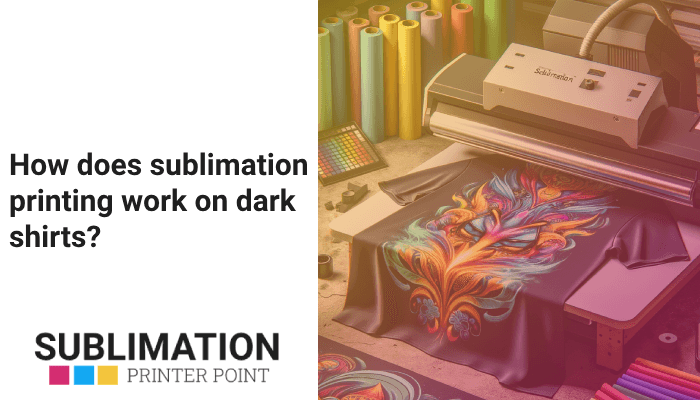Sublimation on dark shirts is the term used in the apparel industry to describe a specialty printing process that uses heat to transfer colors onto different materials. This process is well known for creating prints that are incredibly durable and vibrant.
Sublimation printing is a multipurpose technique that transfers color onto materials such as fabric, paper, and plastic by using heat. Without going through the liquid phase, the dye turns from a solid to a gas and blends in perfectly with the structure of the material. This produces prints that are vivid and long-lasting. Sublimation paper, heat press equipment, sublimation ink, and a substrate made of polyester are essential parts. The process’s capacity to create full-color, all-over fabric prints has made it popular in the clothing industry. Due to the translucent nature of the sublimation ink and the general material composition of dark shirts, printing on them can be difficult.
- Sublimation printing uses heat to transfer dye onto materials, resulting in vibrant, durable prints.
- The process involves key components such as sublimation ink, sublimation paper, a heat press machine, and a polyester-based substrate.
- It’s popular in the garment industry for its ability to produce full-color, all-over apparel prints.
- Printing on dark shirts presents challenges due to the translucent nature of the sublimation ink and the typical material composition of dark shirts.
What is the essence of sublimation printing?
Alternatively referred to as dye-sublimation, sublimation printing is a special technique that uses heat to transfer dye onto materials like cloth, paper, cards, and plastic. The key to this method is its ability to avoid the liquid phase by turning solid dye particles into a gas. Sublimation is the phenomena that causes the dye to blend seamlessly with the structure of the material, producing prints that are vivid and durable. Because sublimation printing provides better color persistence than standard printing techniques, it is a popular option for many industries, including the apparel industry.
What are the key components of sublimation printing?
The process of sublimation printing is complex and requires multiple essential elements. Sublimation paper, heat press equipment, sublimation ink, and a substrate made of polyester are the main components. When heated, the sublimation ink does not go through a liquid phase; instead, it changes from a solid to a gas. The ink passes through a phase change into a gas and is carried by the sublimation paper. The heat and pressure required to make this transition easier are supplied by the heat press machine. Finally, the material that the pattern is put onto is the polyester-based substrate, like a polyester shirt.
How does sublimation ink contribute to the printing process?
Ink sublimation is essential to the printing process. Sublimation ink has the unusual capacity to change from a solid to a gas under pressure and heat, unlike traditional inks. This change enables the ink to seep into the polyester-based substrate’s fibers, producing a vivid, long-lasting print that doesn’t fade. Because of the sublimation ink’s capacity to form a molecular link with the substrate material, the print is not only aesthetically pleasing but also remarkably durable.
Did you know that black shirts don’t work well for sublimation printing? When applied to dark garments, the translucent quality of sublimation ink causes the shirt’s underlying color to peek through, changing the print’s appearance. Use a white underbase or darker colors in the pattern for successful sublimation on dark clothing.
What role does heat press machine play in sublimation printing?
An essential tool in the sublimation printing process is the heat press machine. It offers the required pressure and heat to help the sublimation ink change from a solid to a gas. For a high-quality print, the heat press machine makes sure that the ink is spread equally across the substrate. Nevertheless, the heat press machine’s function goes beyond printing; it also aids in setting the print, guaranteeing its durability and resistance to fading.
Why is sublimation printing popular in the clothing industry?
Because sublimation printing can create prints that are bright and long-lasting, it has become increasingly popular in the apparel industry. Full-color, all-over garment prints are possible with sublimation printing, in contrast to conventional printing techniques. This implies that designs can include the full item of clothing rather than just a tiny section on the front or back, creating a distinctive and eye-catching final result. Furthermore, because the dye forms a molecular link with the cloth, sublimation prints are renowned for their durability and don’t fade or fracture with time.
How does sublimation printing influence the garment printing?
The garment printing business has undergone a revolution thanks to sublimation printing, which provides an unparalleled degree of quality and durability over conventional printing techniques. The method makes it possible to create elaborate, full-color motifs that blend in perfectly with the garment’s fabric. This produces a print that is not only eye-catching but also fade- and crack-resistant. Moreover, sublimation printing gives designers more creative freedom, making it possible to create distinctive, personalized clothes that stand out from the competition.
What makes sublimation printing a preferred choice for custom t-shirts?
Because sublimation printing can create prints that are both durable and of excellent quality, it is the method of choice for creating bespoke t-shirts. The method makes it possible to create elaborate, full-color designs that blend in perfectly with the shirt’s fabric. This produces a print that is not only eye-catching but also fade- and crack-resistant. Moreover, sublimation printing gives designers more creative freedom, making it possible to create distinctive, personalized t-shirts that stand out from the competition.
Here’s a hint: The final print design can be greatly impacted by the selection of sublimation paper. Better sublimation paper can hold more ink, which makes the print more vivid and intricate. To guarantee the finest print quality possible, it is essential to use sublimation paper that is made especially for the kind of ink and printer being used.
How does sublimation printing fit into the print on demand business model?
Because sublimation printing is flexible and efficient, it works well with the print-on-demand business model. Sublimation printing is a great option for companies who sell personalized goods since it allows designs to be printed in any number on a wide range of products, including mugs and t-shirts. Furthermore, the outcome is a high-quality, long-lasting print that satisfies the exacting criteria of today’s discriminating customers because the print is integrated into the product at a molecular level.
What are the challenges of sublimation printing on dark shirts?
Although sublimation printing has many advantages, there are certain difficulties when using it on dark clothes. The main problem is that sublimation ink is translucent, allowing the shirt’s underlying color to peek through. When printing on dark clothes, this may cause the colors to appear subdued or distorted. Furthermore, most dark shirts are composed of cotton or other non-polyester materials, which makes the procedure more difficult. Sublimation printing requires a polyester-based substrate to bond with the ink.
Why is sublimation printing on dark shirts considered difficult?
Because of the nature of the sublimation ink and the typical material composition of dark shirts, sublimation printing on dark shirts is thought to be challenging. When applied to dark clothes, sublimation ink’s translucency causes the shirt’s underlying color to peek through, changing the print’s appearance. It’s also difficult to get a high-quality print with sublimation printing since most dark shirts are made of cotton or other non-polyester materials, which prevents the substrate from bonding with the ink.
How does the color of the shirt affect the sublimation printing process?
The technique of sublimation printing can be greatly impacted by the color of the shirt. Because sublimation ink is translucent, the shirt’s base color may be seen through it. This implies that the colors of the print may appear subdued or changed when printed on dark clothes. Furthermore, on dark shirts, light-colored graphics could not appear at all. Therefore, when organizing a sublimation printing job, it’s imperative to give careful consideration to the shirt’s color.
How can one achieve successful sublimation on dark shirts?
With the correct supplies and careful planning, sublimation on dark shirts can be successfully accomplished. First of all, since sublimation ink adheres best to polyester, it’s imperative to pick a shirt with a high proportion of polyester. Secondly, it’s crucial to modify the design to take the shirt’s color into consideration. To make the print’s colors pop, this can entail employing darker hues in the pattern or adding a white underbase. Lastly, you can increase the likelihood that the design will transfer successfully onto the shirt by utilizing a high-quality heat press machine.
What are the best practices for sublimation printing on dark shirts?
There are a few best practices to adhere to when sublimation printing on dark clothes. First of all, since sublimation ink adheres best to polyester, it’s imperative to pick a shirt with a high proportion of polyester. Secondly, it’s crucial to modify the design to take the shirt’s color into consideration. To make the print’s colors pop, this can entail employing darker hues in the pattern or adding a white underbase. Lastly, you can increase the likelihood that the design will transfer successfully onto the shirt by utilizing a high-quality heat press machine.
How does the choice of sublimation paper impact the final print design?
The final print design can be greatly impacted by the selection of sublimation paper. Better sublimation paper can hold more ink, which makes the print more vivid and intricate. Moreover, the sharpness and clarity of the design may be impacted by the paper’s capacity to release ink when heated. To guarantee the finest print quality possible, it is essential to use sublimation paper that is made especially for the kind of ink and printer being used.

What role does fabric type, like polyester shirts, play in sublimation printing?
When sublimation printing, the type of fabric is very important. Polyester fabrics and sublimation ink work well together to create vivid, long-lasting prints. Applying ink to polyester shirts causes the print to become embedded in the fabric as it penetrates the fibers. This produces a print that is not only eye-catching but also fade- and crack-resistant. To obtain the highest print quality possible, it is crucial to use a premium polyester shirt when organizing a sublimation printing job.
What are the future trends in sublimation printing and fashion design?
Fashion design and sublimation printing trends are always changing along with technology. Using digital printing technologies to produce increasingly detailed and intricate graphics is one rising trend. Fashion design now has more options because to this technology, which also makes it possible to print on a wide range of materials with more design flexibility. Furthermore, a developing trend in the printing industry is the use of sustainable materials and eco-friendly sublimation inks, as customers grow more aware of environmental issues.
How is digital printing revolutionizing the textile industry?
Because digital printing offers a level of accuracy and flexibility that traditional printing technologies cannot match, it is completely changing the textile business. With the use of this technique, complex, full-color graphics may be produced and printed on a range of materials, including polyester and cotton. Moreover, digital printing enables production on demand, which lowers waste and improves the sustainability of the process. As a result, many in the textile business are starting to prefer digital printing.
What are the emerging trends in graphic design for sublimation printing?
Graphic design trends are evolving in tandem with sublimation printing. Using intricate, full-color designs that capitalize on the sublimation printing process’s capacity to create vivid, long-lasting prints is one new trend. Furthermore, there’s an increasing trend in the design process to use sustainable materials and eco-friendly sublimation inks as consumers become more ecologically sensitive. Furthermore, designers can now produce more detailed and sophisticated designs than ever before thanks to advancements in digital printing technology.

